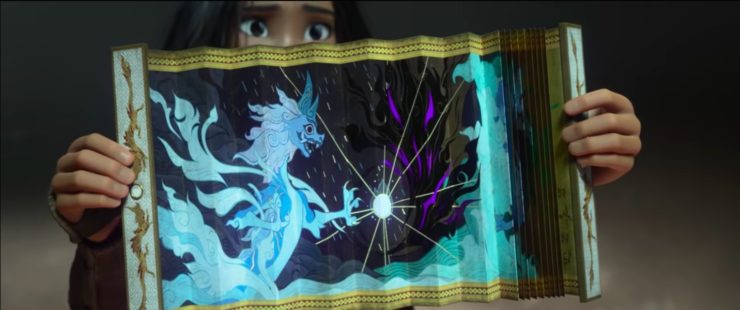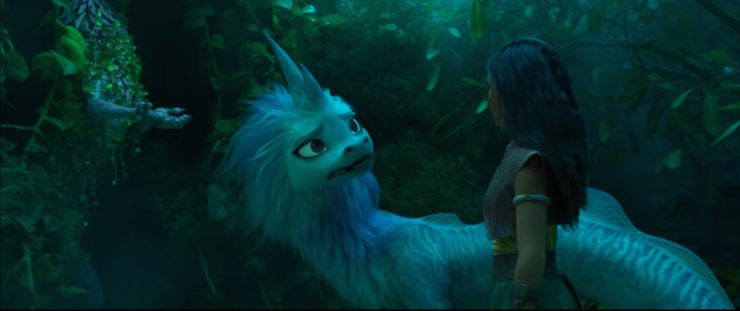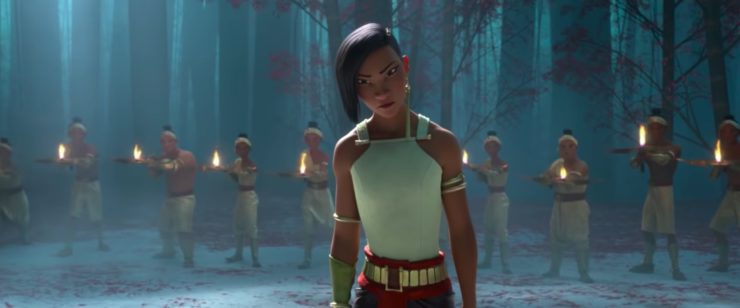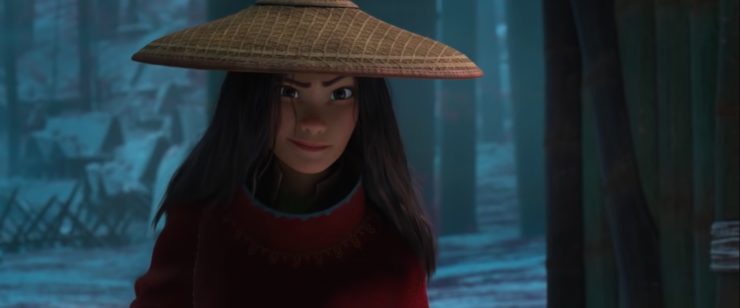It’s not every Disney movie that leaves you thinking about food. Raya and the Last Dragon is a lush, gorgeous work of animation with epic fight scenes, a doubting heroine, and a giddy water dragon—and it’s a movie that remembers that people need to eat, and that eating together is meaningful. Watching the enterprising young chef Boun (Izaac Wang) dole out his dishes to a gaggle of newfound friends, I missed more than ever the experience of food as community, as a reason and a way to come together.
Early in the film, Chief Benja (Daniel Dae Kim) uses food as an example of how different elements create a magical whole. He adds something from each of his world’s five lands—shrimp paste, lemongrass, bamboo shoots, chilis, and palm sugar—to a bowl of soup. Every piece is necessary for the dish to be complete. It reflects his dream for their broken world: That the five clashing nations of Heart, Talon, Fang, Spine, and Tail can reunite as Kumandra, the single harmonious world they once were.
[Minor spoilers for the film below.]
Centuries ago, Kumandra was broken apart after being invaded by the Druun, a destructive force that looks like little more than purple scribbles. (Purple is having a big week in SFF properties.) The Druun turned everything to stone, sweeping across Kumandra until they were stopped by the power of the dragon gem, a magical stone created by the last surviving dragons.
All these years later, young Raya (Kelly Marie Tran) is completing her training as one of the guardians of the gem, which was entrusted to her land, Heart. It’s not clear why the gem went to Heart, but Spine, Fang, Talon and Tail resent this situation, believing the dragon gem bestows greater prosperity on Heart. When Chief Benja, in his desire to reunite Kumandra, invites the leaders of all the other nations over for dinner, the adults are skeptical. It’s the kids, Raya and Fang princess Namaari (Jona Xiao), who break the diplomatic ice by bonding over their love of the mythical Sisu, the dragon credited with saving their world from the Druun. Namaari even gives Raya a necklace shaped like the dragon.

But minutes later, Namaari turns on Raya, trying to claim the dragon gem for Fang. When all the factions get in on the squabble, the gem is broken, and the Druun freed once more.
The backstory of the Druun is a little inconsistent; later in the film Raya says they come from human discord, but if everything was so peaceful 500 years ago, how did they manifest? It kind of doesn’t matter; they just are, and they turn everyone to stone—including Raya’s father. It’s up to her to set things right.
Which is what we find her doing six years after this prologue—traveling with her trusty friend Tuk Tuk (is he an armadillo? A pill bug? Does it matter? He’s perfect). Raya, who blames herself for what happened, is hunting down the place where Sisu the dragon was rumored to wind up after she saved the world. Namaari (voiced as an adult by Gemma Chan) is also on the hunt, trying to retrieve a dragon scroll Raya took from her.
It’s not a surprise that Raya finds Sisu (Awkwafina). But Sisu herself is not what Raya expected. A goofy water dragon, proud of her strong swimming skills, she isn’t quite the mythic, world-saving beast Raya imagined her to be. What she’s best at is what Raya cannot bring herself to do: Sisu wants to believe the best of people. Also, she has a specific philosophy about gifts that jars with Raya’s experience with Namaari: “A gift says, You can trust me. Can I trust you?”

Notably, Raya did not bring Sisu a gift either, but the dragon still joins her on a journey to collect all five broken pieces of the dragon gem. It’s a bit of a video game quest—visit each land to collect a shiny prize!—but it takes us to the dry wasteland of Tail, the dark, red-petal-dotted landscape of Spine, the night market of Talon, and, eventually, the marvelous, elegant island palace of Fang. Each location is precisely differentiated, and in each, Raya picks up another orphan: the young chef Boun; Noi (Thalia Tran), the con baby, with her little gang of monkeys; and Tong (Benedict Wong), a massive warrior. Every one of them has lost their family to the Druun—and every one has something to offer, if only Raya can see it. But she’s resistant to any view of the world but her own.

At times, Raya tries too hard to be funny, leaning on Sisu’s hyperactive chatter a little more than the character can bear. Her delight and hope are more effective mood-lifters than her jokes. And the movie does need moments of lightness to balance the fairly intense sense of loss and mourning. The Druun’s eerie stone victims dot every landscape, both tragic and ever so slightly hopeful (turned to stone is better than dead, where magic is concerned!). Raya’s motivation is guilt, a stubborn hope, and the loss of her father, and though the film doesn’t dwell on it, everyone she meets shares that loss. Their grief is specific, but it’s collective, too. The huge team of filmmakers—including co-directors Don Hall (Moana) and Carlos López Estrada (Blindspotting), and head of story Fawn Veerasunthorn—were working to finish Raya over the last year. It was partially created with everyone working remotely as a pandemic rolled across the world. Wisely, they don’t lean on the parallels—but you can feel them.
Raya is a movie that knows it arrives in a difficult time. (“How did this world get so broken?” Raya asks in the initial voiceover.) Screenwriters Adele Lim and Qui Nguyen are careful not to tell an oversimplified tale about how if everyone just trusted each other, everything would be shiny and great. Blithely trusting just anyone doesn’t help (as Sisu has to learn, because even dragons are fallible). The movie is more interested in the trust that needs to exist between people who are genuinely striving for the same goal—even if, in the case of Raya and Namaari, they’re doing it for different reasons.

Namaari’s motivation, though, needs more exploration. Like Raya, she’s very much her single parent’s child, and her mother, Virana (Sandra Oh), has specific reasons for wanting to claim all the pieces of the gem for Fang. But what does Namaari want? Raya’s guilt and loss get far more screen time than that of her nemesis, which weakens the power of Namaari’s journey. But it didn’t stop me from tearing up at Namaari’s eventual role, and the gesture Raya makes when everything is at its bleakest. (Also? These two are not just frenemies. There are way too many meaningful glances.)
It’s sometimes hard to fully embrace a plot about trust. It can feel a little naive to believe that the solution to a world-destroying problem is as simple as choosing to believe the best of someone instead of the worst. Nobody wants to be the person who holds out a hand only to have it slapped down. That kind of vulnerability, once taken advantage of, is hard to regain, and Raya’s bitterness has blossomed into an almost toxic self-sufficiency that doesn’t allow for what she needs most—help. Raya and Sisu come down on different sides of a fundamental divide: Is the world broken because people don’t trust each other, or do people not trust each because the world is broken? As Sisu says, mournfully, “Being people is hard.”
One of the big talking points about Raya os that it’s Disney’s first film with a Southeast Asian princess, and the company’s first film inspired by Southeast Asia. I’m not the writer to detail how that does or doesn’t work, and I recommend reading the perspectives of Southeast Asian critics, including Hoai-Tran Bui at SlashFilm. (On Twitter, Reyzando Nawara has been collecting reviews by Southeast Asian critics here.) To my outsider eye, it looks like a lot of love and attention went into the details of this world, from the fighting styles and weapons to the bowls of shrimp congee and lychee to the different architecture and clothing styles of the different lands. It’s a mashup of influences and references, inspired by but not directly representing the countries the directors visited for material: Cambodia, Indonesia, Laos, Malaysia, Singapore, Thailand, and Vietnam.
And visually, it’s just incredibly beautiful. Every time Namaari and Raya clash, the crisp, richly choreographed fights are a treat to behold. Dragons bring water to the land, and water figures significantly throughout, from the colorful footprints of a dragon in the sky to one breathtaking image of people setting blossoms afloat as a memorial for missing family members. Raya’s hair is a work of art all on its own. The play of light, whether in the night market of Talon or the shadowed woods of Spine, has depth and nuance in a way I don’t think I’ve ever seen in Disney animation before. Every artist involved here deserves all the awards.

So, for that matter, does Kelly Marie Tran, who voices Raya at both ages with layered precision, from childish enthusiasm to the bitterness of a young woman who seems to have spent six years with only Tuk Tuk for company (look, he’s great, I love him, I would buy the stuffed animal, but he doesn’t talk). She carries this film, though Daniel Dae Kim is wonderful as her warm, loving father, and Gemma Chan does everything she can with Namaari’s underdeveloped character.
Raya is a film not just about learning to trust people—but also about the power of being trusted. Learning to trust is only part of the story. Being trusted is a gift, and also a heavy weight, a thing that requires a lot of a person. Raya carried that burden along with her father’s hope. Namaari does, too, in her mother’s faith.
There’s a moment in the finale that just crushed me—an instance of both letting go and taking on the weight of the world. It’s a moment of dropping all defenses and pretenses and letting hope in, and having that action be rewarded. Raya’s defensiveness, her fear of trusting, her need to do it all herself—the way she comes to understand that other people can help in their own ways, that everything isn’t on her shoulders—all of this will likely resonate with my fellow perfectionists. I admit that I don’t always want to have an open heart for heavy-handed Disney messaging. But Raya doesn’t shame its heroine for her bitterness, doesn’t linger on her mistakes. Gently, the story gives her the space to come around on her own time. We don’t all get that. But seeing it on screen cracked something in me that needed cracking, especially after this last year. I hope it does the same for you.
Molly Templeton lives and writes in Oregon, and spends as much time as possible in the woods. You can also find her on Twitter.










